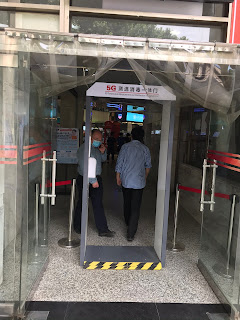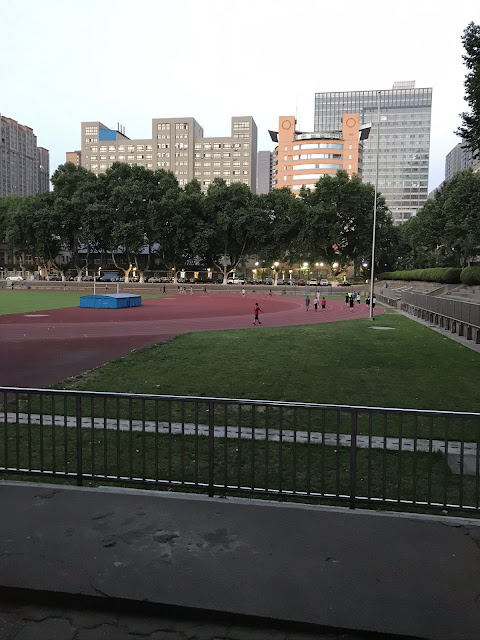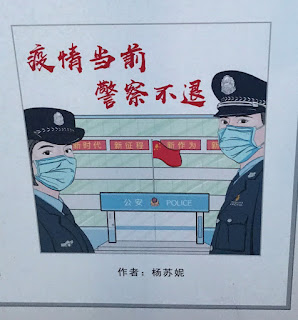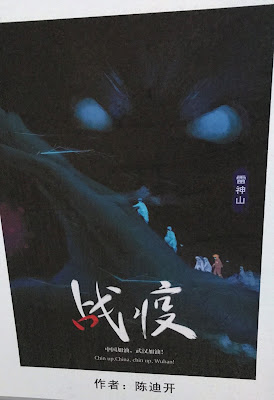How do you open a University: An essay in pictures
How do you reopen a University?
 |
| Pavilion on my way to teach |
That is the question that many have been asking since
quarantine began. In one article, an
administrator observes: “Our colleges and universities are in
many ways like small cities… [only] more compacted with much higher density of
people… When you think about a public health threat, or in this case the
COVID-19 virus, it really is very complex.” (Sarah Van Orman, Associate
Vice-Provost, Insider HigherEd). Despite these complexities, the President of Brown University called the reopening of
Schools and Universities the highest national priority:
“Institutions should develop public
health plans now that build on three basic elements of controlling the spread
of infection: test, trace and separate.”(Christine Paxton, New York
Times.
Well, that sounds simple! Just test, trace and separate!
Of course, it is more complicated than that. The one piece that both administrators are missing, however, is the psychological component. What
would make you feel safe if you’re a teacher? What would make you feel safe, if
you’re a parent or a student?
These aren’t theoretical questions for me. China—specifically
Jiaotong University, where I’m teaching – has reopened its universities. We re-started last week, May 25. We have two weeks left of Spring term. We then have approximately 3 weeks of exams,
and then we start the short summer term.
Was it successful? We really won’t
know until we can be sure there were no outbreaks. But the psychological show of safety and
support was clear and evident in every gesture.
So, come. See my new
campus, as we open up.
* * *
One of the first things that was installed -- way back on March 21-- were outdoors hand-washing stations. These are located outside all of the large student buildings-- canteen, student activity center, etc.
The university took their cues from the high schools which also opened about this time. High schools are different from Universities. Universities and colleges bring in students from all over. As in the US, high schools in China are primarily local. But, the methods used by the high schools were adopted by the University. Below is a picture of one of the high schools opening on April 4th:
We next saw hand sanitizer appear every where -- outside elevators, as you enter classroom, as you enter buildings.
Added to the hand-washing stations were large tents that checked people in, if the large buildings (canteen, library or student center) got too crowded. They presumably would deal with overflow, preventing too many people from entering the building
A week before classes started, entry to the campus became very strict. Barriers were set up. Lines demarcated the way to enter the campus. Foot prints showed the distances that should be maintained between people lining up. There were temperature-taking stations, the ubiquitous QR station that checks to make sure that you are a student or staff member at the university, and of course hand sanitizer.
Prior to the students' return, in each student's dorm room, every student received a packet. It included masks, a thermometer, a card on what to do if you have any COVID symptoms, and the rules of the campus.
- Take your temperature daily.
- Wear a mask,
- No crowds.
Also, if, in the last three months, you were out of China -- Taiwan, or on a study abroad program last term--you had to quarantine out at the outer ring campus -- the Innovation Harbor campus. (The I-Harbor campus is a brand new campus that was built by President Xi for the 70th Anniversary of Communist China. It's a large monstrosity, of Tiananmen Square proportions. But it doesn't really have any students yet, so it is a convenient place to quarantine.)
In addition, all students are required to stay on campus. They can't leave the perimeter for restaurant food, groceries or any type of shopping. We found this out when David invited his conversation class to meet him at a Cafe, just outside the campus entrance. The students said that they weren't allowed to leave campus. There are foods stores, cafeterias and drugstore/stationary stores on campus. They are expected to use those. This is sad for the businesses outside of campus, who I'm sure were looking forward to an uptick in business with the students' return.
The canteen was well marked. There was a station that looked like an airport security gate. You had to look into the screen and it would check your face...for what, I'm not sure! Maybe to make sure you belonged in the school, or to check your temperature, and other vitals? Once you got in, you were shown how to line up for food -- 6 feet apart. The tables were constructed with barriers, and clear markings on where and how to sit.

Other buildings, too, have temperature-taking security gates, and elaborate instructions on how to enter the building.

And here is the track --not as crowded as it was Fall term, but still people were walking, exercising and out and about.
As for teaching, classrooms were moved to bigger spaces, so that social distancing could be practiced in each class. You can see in these two pictures, the red dot on the chair tells you where not to sit:

And here is my class the first day of school. Most are complying with the seating assignments. All were wearing masks, until I pulled out my camera. They didn't want to go into a blog with their face covered....😊
During break, however, it became harder to follow the rules:
So, what did I teach? Why, Edgar Allen Poe's "Masque of the Red Death"-- of course! Frivolous rulers who party while their people die of the red death -- what could provoke more conversation? The unit that I'm teaching I'm calling "Witnessing." We're looking at literature that offers commentary or criticism on society.
When I asked my students what they thought Poe was criticizing, this was what they came up with:
Irene cautiously noted:
The Red
Death is quite similar to COVID-19 today. This ending shows the consequence of
people’s escape from responding to it. Only when people around the world cooperate together to fight against it, can
we conquer the virus.
Dorothy saw a similar message:
The warning of death was provided by
the pendulum clock, but they ignored it. For the prince and his courtiers,
the more they fantasize, the harder it is for them to prepare for the “Red
Death”. They do possess power, money, status, but no notion about pestilence or
sickness, let alone sympathy and duty. Isolation and escape are not the
solution to the problem. Human beings cannot fight against the natural
disasters unless we are united to focus on overcoming difficulties
Joy was even more direct:
I
think Poe was “witnessing” that a pandemic can spread and thousands of people die in the epidemics. But the governors ignore
the devastation of the epidemic and aren't concerned about the lives of ordinary
people. They were addicted to entertainment.
He
is criticizing the attitude and methods that the governors take when facing the
epidemic. “But the Prince Prospero was happy and dauntless and sagacious”: it is
an obvious example of satire. The governor just cared about themselves and
those people close to them. What they did first was not make plans or find out solutions for the epidemic, but they chose to escape and work out a way to
protect themselves. They recognized the power of the epidemic but
they ignored and wanted to fight with it directly. So, at last, they pay with
their lives for their mistakes.
Yvonne makes an even clearer connection between 1842 and 2020:
Poe is witnessing the ignorance and
indulgence in the society, and he is criticizing this phenomena. This story
written by Allan Poe in 1850 fits perfectly into the current occasion of
Covid-19 pandemic. It provides us with lots of inspirations for the current
situation. My friends who are studying in Europe told me that no one on the
street wears masks. People are turning their blind eyes to the serious
infectious disease. And the disease comes to them. People are acting as if it
is not a big deal, and the reasons for their actions are complicated. Some of
them simply refuse to admit the reality, hoping to relieve themselves by this
temporary self-fooling. Others might have more complicated reasons. By reading
the story, we know there are two attitudes when facing life, one is to face it
directly, the other is to escape from it. It is hard to tell which one is more
reasonable actually. In my opinions, Poe is not specifically criticizing on any
of them, because both of the people inside and outside the palace are pathetic,
and they are all fooled by death. More pathetically is that, we are also
members of them, either inside or outside. It seems that we have a choice, but
actually we don’t.
Not bad....
* * *
I mentioned at the opening that it is important to address the psychological as well as physical feelings faced when you return to campus. One prominent exhibition that greets the students as they enter campus is an exhibit of patriotic posters, warning everyone that the battle is not finished, but congratulating on the work done so far. Here are a few of them.
Some celebrated service personnel:
Some emphasized the hard work. These two exhort: Chin up, China! Chin up, Wuhan! while an malevelant face watches the struggling figures.
Some emphasize strength:
Some seemed to suggest a sort of supernatural, manga-esque battle:
Some looked more scientific:
Finally some are uniquely Chinese:
All of this suggests that opening up schools in China required both substance as well as show. It also shows that no matter how much planning you take, it will be difficult to fully enforce the rules. The students wore their masks and sat dutifully for the first half of class, but class isn't me lecturing and them taking notes. Once we had break, once we started our discussions, it was harder to stay in the seats with red dots. Associate Vice-Provost Sarah Van Orman calls Universities "little cities." I'd revise that and call them big families. When we open, and you hold your first family barbecue, will everyone social distance? Will you all be able to keep on your masks or keep from hugging each other? China is trying, and I think this is a nice game-plan for helping the inhabitants of our campus to feel safe. But whether it will protect us all? Time alone will tell.



























Comments
Post a Comment